Power of Media in influencing Health Policy and Politics Assignment
VerifiedAdded on 2021/06/16
|12
|3638
|41
AI Summary
Contribute Materials
Your contribution can guide someone’s learning journey. Share your
documents today.
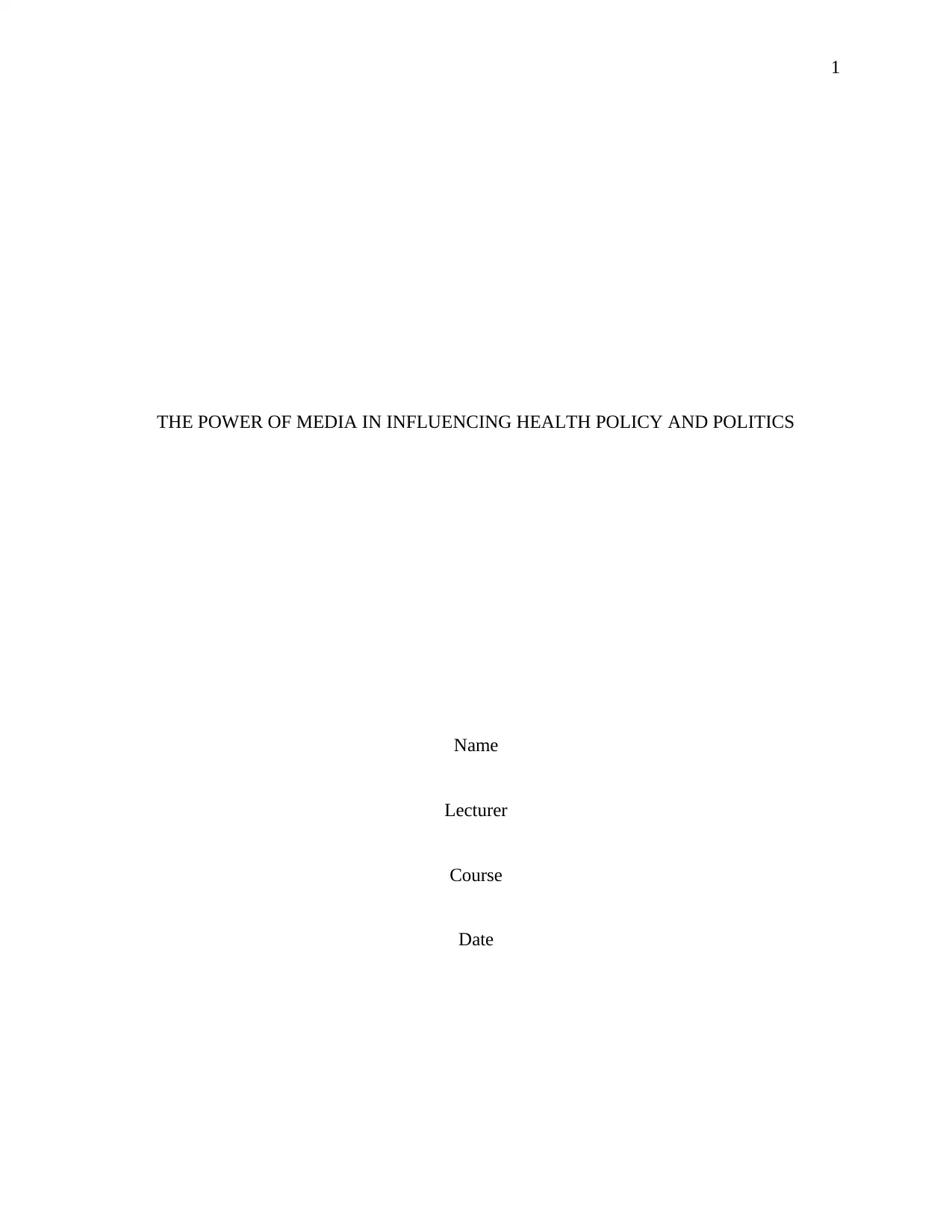
1
THE POWER OF MEDIA IN INFLUENCING HEALTH POLICY AND POLITICS
Name
Lecturer
Course
Date
THE POWER OF MEDIA IN INFLUENCING HEALTH POLICY AND POLITICS
Name
Lecturer
Course
Date
Secure Best Marks with AI Grader
Need help grading? Try our AI Grader for instant feedback on your assignments.
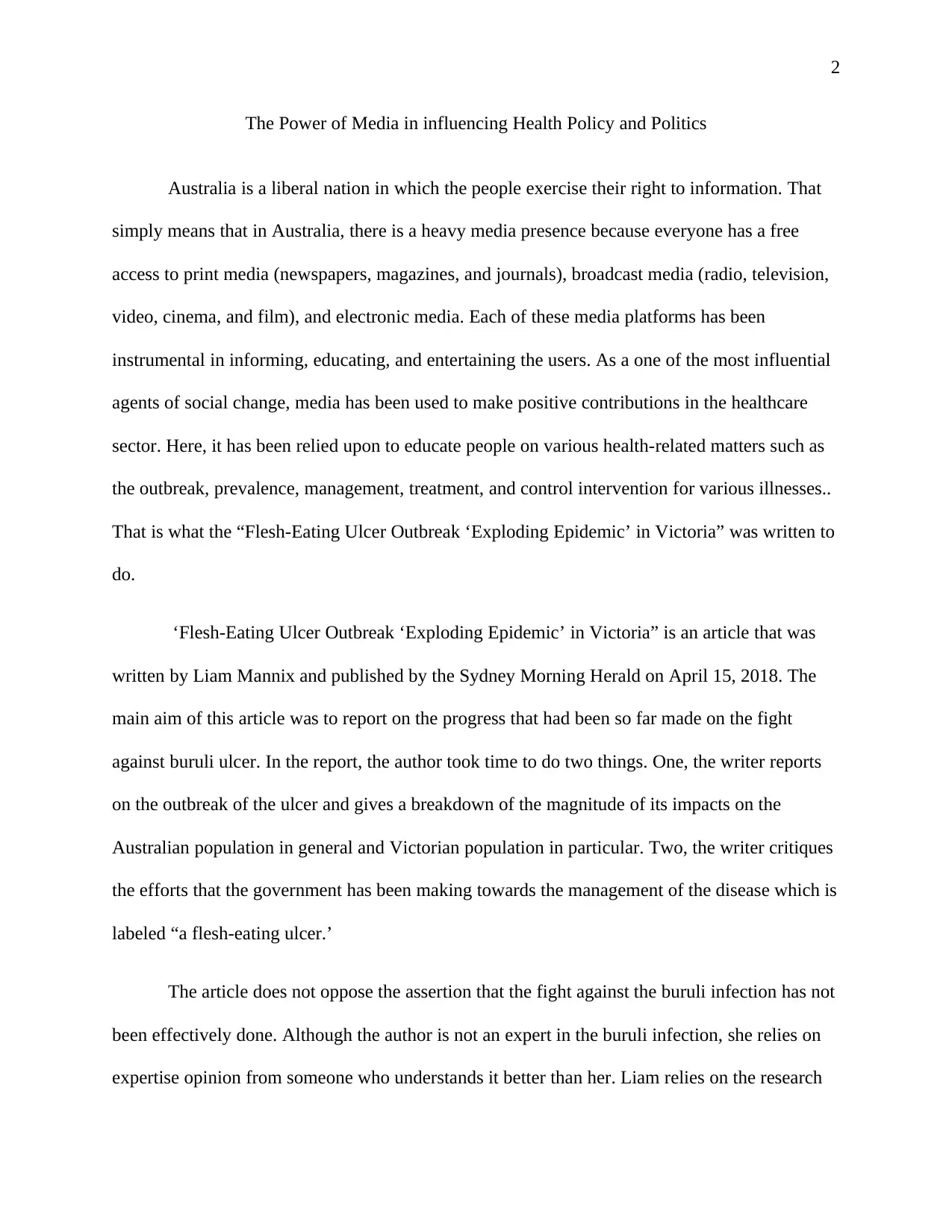
2
The Power of Media in influencing Health Policy and Politics
Australia is a liberal nation in which the people exercise their right to information. That
simply means that in Australia, there is a heavy media presence because everyone has a free
access to print media (newspapers, magazines, and journals), broadcast media (radio, television,
video, cinema, and film), and electronic media. Each of these media platforms has been
instrumental in informing, educating, and entertaining the users. As a one of the most influential
agents of social change, media has been used to make positive contributions in the healthcare
sector. Here, it has been relied upon to educate people on various health-related matters such as
the outbreak, prevalence, management, treatment, and control intervention for various illnesses..
That is what the “Flesh-Eating Ulcer Outbreak ‘Exploding Epidemic’ in Victoria” was written to
do.
‘Flesh-Eating Ulcer Outbreak ‘Exploding Epidemic’ in Victoria” is an article that was
written by Liam Mannix and published by the Sydney Morning Herald on April 15, 2018. The
main aim of this article was to report on the progress that had been so far made on the fight
against buruli ulcer. In the report, the author took time to do two things. One, the writer reports
on the outbreak of the ulcer and gives a breakdown of the magnitude of its impacts on the
Australian population in general and Victorian population in particular. Two, the writer critiques
the efforts that the government has been making towards the management of the disease which is
labeled “a flesh-eating ulcer.’
The article does not oppose the assertion that the fight against the buruli infection has not
been effectively done. Although the author is not an expert in the buruli infection, she relies on
expertise opinion from someone who understands it better than her. Liam relies on the research
The Power of Media in influencing Health Policy and Politics
Australia is a liberal nation in which the people exercise their right to information. That
simply means that in Australia, there is a heavy media presence because everyone has a free
access to print media (newspapers, magazines, and journals), broadcast media (radio, television,
video, cinema, and film), and electronic media. Each of these media platforms has been
instrumental in informing, educating, and entertaining the users. As a one of the most influential
agents of social change, media has been used to make positive contributions in the healthcare
sector. Here, it has been relied upon to educate people on various health-related matters such as
the outbreak, prevalence, management, treatment, and control intervention for various illnesses..
That is what the “Flesh-Eating Ulcer Outbreak ‘Exploding Epidemic’ in Victoria” was written to
do.
‘Flesh-Eating Ulcer Outbreak ‘Exploding Epidemic’ in Victoria” is an article that was
written by Liam Mannix and published by the Sydney Morning Herald on April 15, 2018. The
main aim of this article was to report on the progress that had been so far made on the fight
against buruli ulcer. In the report, the author took time to do two things. One, the writer reports
on the outbreak of the ulcer and gives a breakdown of the magnitude of its impacts on the
Australian population in general and Victorian population in particular. Two, the writer critiques
the efforts that the government has been making towards the management of the disease which is
labeled “a flesh-eating ulcer.’
The article does not oppose the assertion that the fight against the buruli infection has not
been effectively done. Although the author is not an expert in the buruli infection, she relies on
expertise opinion from someone who understands it better than her. Liam relies on the research
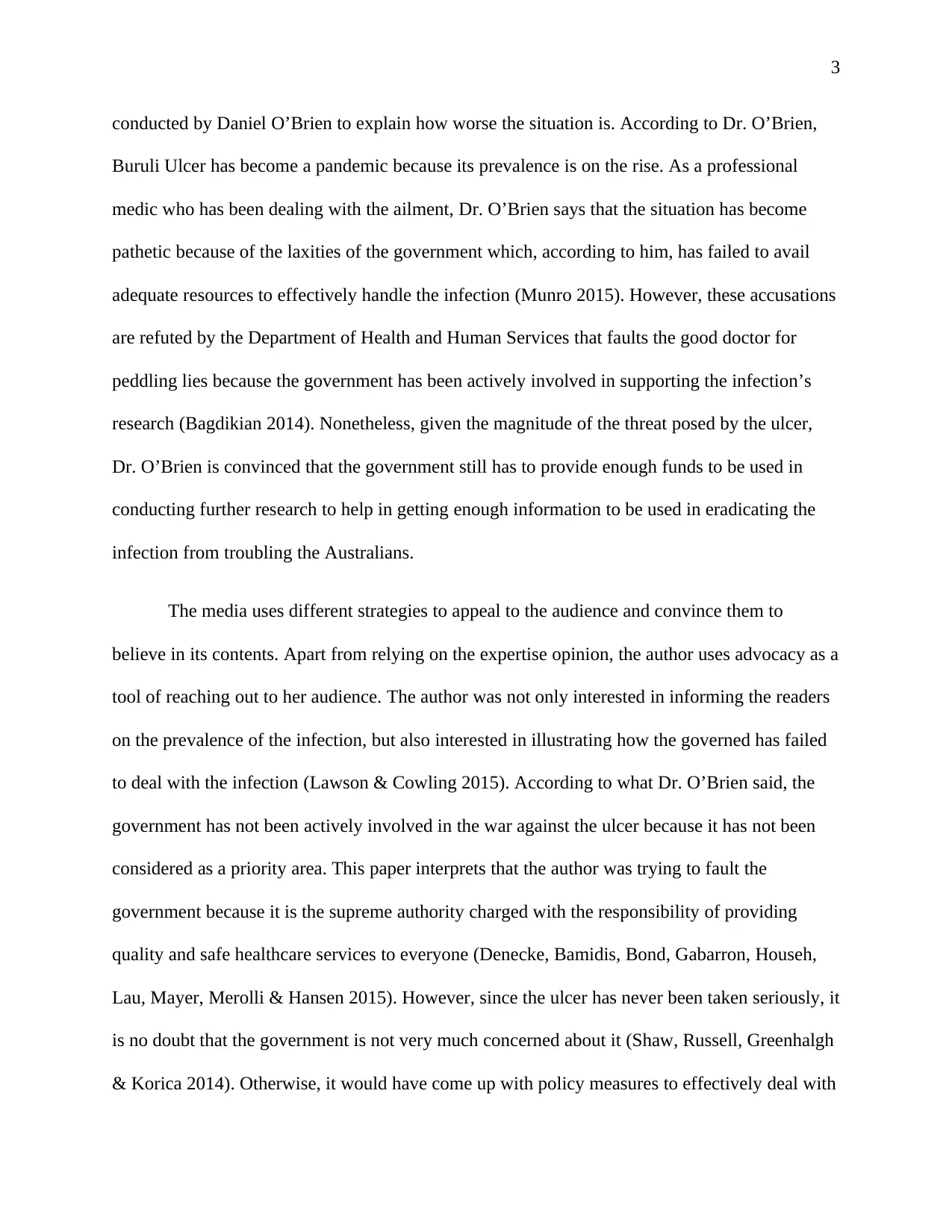
3
conducted by Daniel O’Brien to explain how worse the situation is. According to Dr. O’Brien,
Buruli Ulcer has become a pandemic because its prevalence is on the rise. As a professional
medic who has been dealing with the ailment, Dr. O’Brien says that the situation has become
pathetic because of the laxities of the government which, according to him, has failed to avail
adequate resources to effectively handle the infection (Munro 2015). However, these accusations
are refuted by the Department of Health and Human Services that faults the good doctor for
peddling lies because the government has been actively involved in supporting the infection’s
research (Bagdikian 2014). Nonetheless, given the magnitude of the threat posed by the ulcer,
Dr. O’Brien is convinced that the government still has to provide enough funds to be used in
conducting further research to help in getting enough information to be used in eradicating the
infection from troubling the Australians.
The media uses different strategies to appeal to the audience and convince them to
believe in its contents. Apart from relying on the expertise opinion, the author uses advocacy as a
tool of reaching out to her audience. The author was not only interested in informing the readers
on the prevalence of the infection, but also interested in illustrating how the governed has failed
to deal with the infection (Lawson & Cowling 2015). According to what Dr. O’Brien said, the
government has not been actively involved in the war against the ulcer because it has not been
considered as a priority area. This paper interprets that the author was trying to fault the
government because it is the supreme authority charged with the responsibility of providing
quality and safe healthcare services to everyone (Denecke, Bamidis, Bond, Gabarron, Househ,
Lau, Mayer, Merolli & Hansen 2015). However, since the ulcer has never been taken seriously, it
is no doubt that the government is not very much concerned about it (Shaw, Russell, Greenhalgh
& Korica 2014). Otherwise, it would have come up with policy measures to effectively deal with
conducted by Daniel O’Brien to explain how worse the situation is. According to Dr. O’Brien,
Buruli Ulcer has become a pandemic because its prevalence is on the rise. As a professional
medic who has been dealing with the ailment, Dr. O’Brien says that the situation has become
pathetic because of the laxities of the government which, according to him, has failed to avail
adequate resources to effectively handle the infection (Munro 2015). However, these accusations
are refuted by the Department of Health and Human Services that faults the good doctor for
peddling lies because the government has been actively involved in supporting the infection’s
research (Bagdikian 2014). Nonetheless, given the magnitude of the threat posed by the ulcer,
Dr. O’Brien is convinced that the government still has to provide enough funds to be used in
conducting further research to help in getting enough information to be used in eradicating the
infection from troubling the Australians.
The media uses different strategies to appeal to the audience and convince them to
believe in its contents. Apart from relying on the expertise opinion, the author uses advocacy as a
tool of reaching out to her audience. The author was not only interested in informing the readers
on the prevalence of the infection, but also interested in illustrating how the governed has failed
to deal with the infection (Lawson & Cowling 2015). According to what Dr. O’Brien said, the
government has not been actively involved in the war against the ulcer because it has not been
considered as a priority area. This paper interprets that the author was trying to fault the
government because it is the supreme authority charged with the responsibility of providing
quality and safe healthcare services to everyone (Denecke, Bamidis, Bond, Gabarron, Househ,
Lau, Mayer, Merolli & Hansen 2015). However, since the ulcer has never been taken seriously, it
is no doubt that the government is not very much concerned about it (Shaw, Russell, Greenhalgh
& Korica 2014). Otherwise, it would have come up with policy measures to effectively deal with
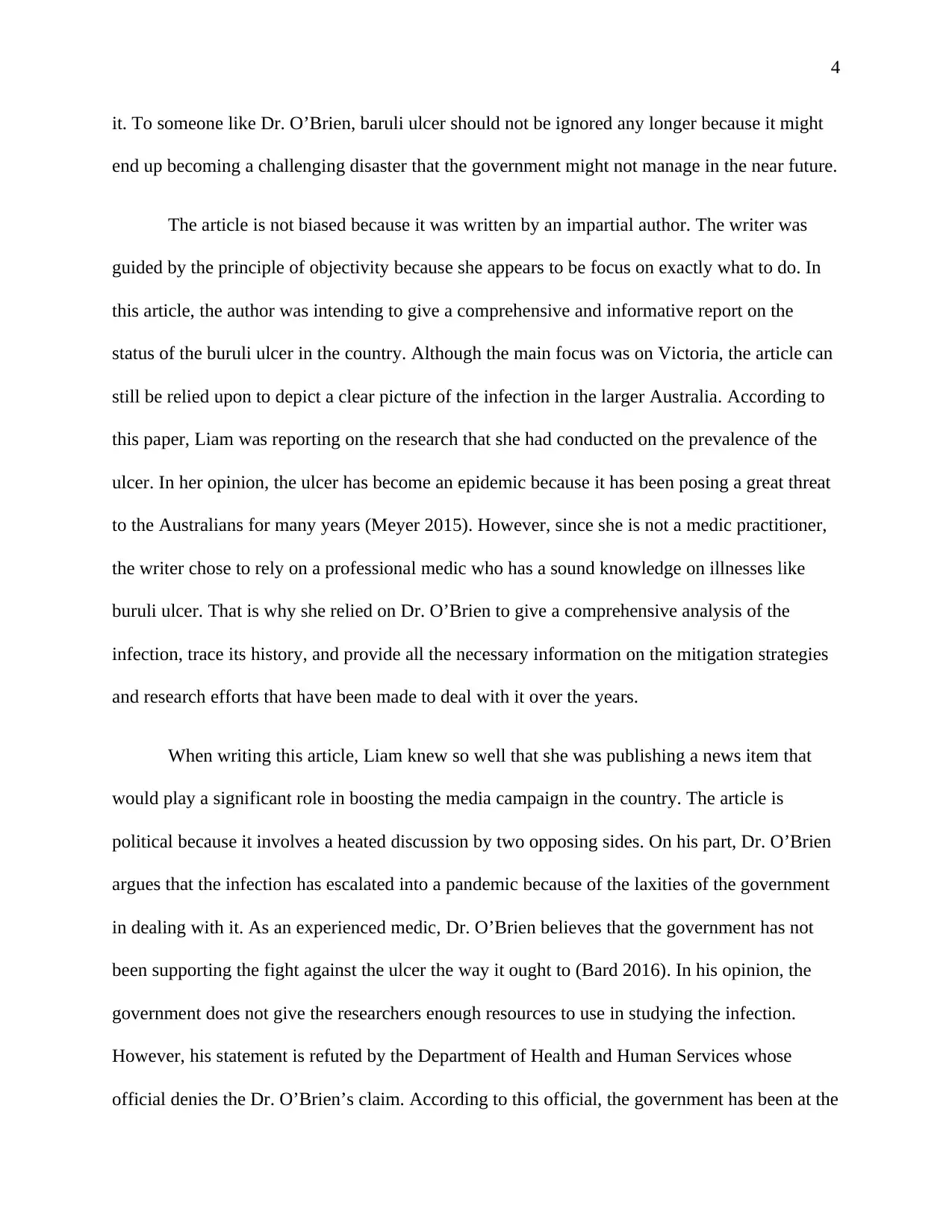
4
it. To someone like Dr. O’Brien, baruli ulcer should not be ignored any longer because it might
end up becoming a challenging disaster that the government might not manage in the near future.
The article is not biased because it was written by an impartial author. The writer was
guided by the principle of objectivity because she appears to be focus on exactly what to do. In
this article, the author was intending to give a comprehensive and informative report on the
status of the buruli ulcer in the country. Although the main focus was on Victoria, the article can
still be relied upon to depict a clear picture of the infection in the larger Australia. According to
this paper, Liam was reporting on the research that she had conducted on the prevalence of the
ulcer. In her opinion, the ulcer has become an epidemic because it has been posing a great threat
to the Australians for many years (Meyer 2015). However, since she is not a medic practitioner,
the writer chose to rely on a professional medic who has a sound knowledge on illnesses like
buruli ulcer. That is why she relied on Dr. O’Brien to give a comprehensive analysis of the
infection, trace its history, and provide all the necessary information on the mitigation strategies
and research efforts that have been made to deal with it over the years.
When writing this article, Liam knew so well that she was publishing a news item that
would play a significant role in boosting the media campaign in the country. The article is
political because it involves a heated discussion by two opposing sides. On his part, Dr. O’Brien
argues that the infection has escalated into a pandemic because of the laxities of the government
in dealing with it. As an experienced medic, Dr. O’Brien believes that the government has not
been supporting the fight against the ulcer the way it ought to (Bard 2016). In his opinion, the
government does not give the researchers enough resources to use in studying the infection.
However, his statement is refuted by the Department of Health and Human Services whose
official denies the Dr. O’Brien’s claim. According to this official, the government has been at the
it. To someone like Dr. O’Brien, baruli ulcer should not be ignored any longer because it might
end up becoming a challenging disaster that the government might not manage in the near future.
The article is not biased because it was written by an impartial author. The writer was
guided by the principle of objectivity because she appears to be focus on exactly what to do. In
this article, the author was intending to give a comprehensive and informative report on the
status of the buruli ulcer in the country. Although the main focus was on Victoria, the article can
still be relied upon to depict a clear picture of the infection in the larger Australia. According to
this paper, Liam was reporting on the research that she had conducted on the prevalence of the
ulcer. In her opinion, the ulcer has become an epidemic because it has been posing a great threat
to the Australians for many years (Meyer 2015). However, since she is not a medic practitioner,
the writer chose to rely on a professional medic who has a sound knowledge on illnesses like
buruli ulcer. That is why she relied on Dr. O’Brien to give a comprehensive analysis of the
infection, trace its history, and provide all the necessary information on the mitigation strategies
and research efforts that have been made to deal with it over the years.
When writing this article, Liam knew so well that she was publishing a news item that
would play a significant role in boosting the media campaign in the country. The article is
political because it involves a heated discussion by two opposing sides. On his part, Dr. O’Brien
argues that the infection has escalated into a pandemic because of the laxities of the government
in dealing with it. As an experienced medic, Dr. O’Brien believes that the government has not
been supporting the fight against the ulcer the way it ought to (Bard 2016). In his opinion, the
government does not give the researchers enough resources to use in studying the infection.
However, his statement is refuted by the Department of Health and Human Services whose
official denies the Dr. O’Brien’s claim. According to this official, the government has been at the
Secure Best Marks with AI Grader
Need help grading? Try our AI Grader for instant feedback on your assignments.
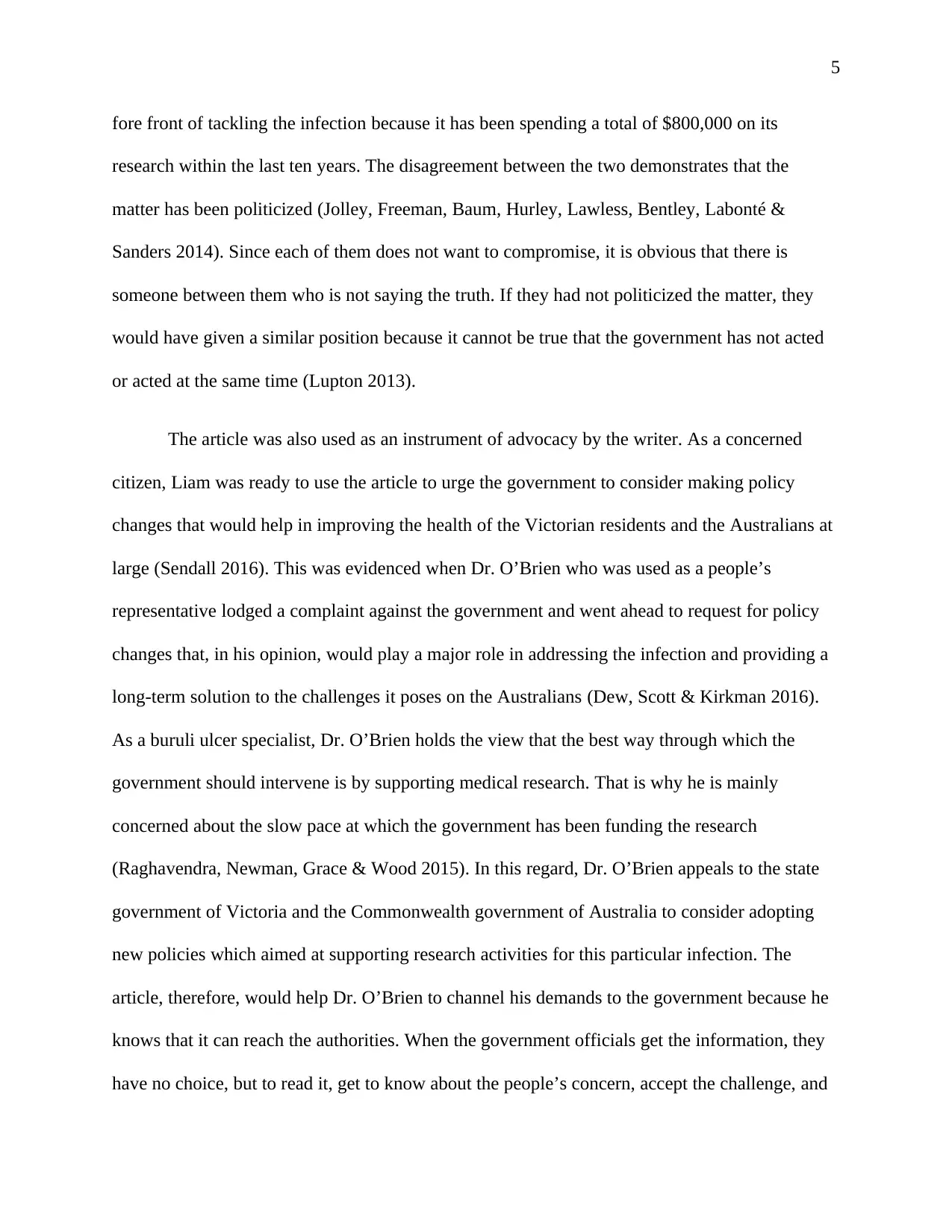
5
fore front of tackling the infection because it has been spending a total of $800,000 on its
research within the last ten years. The disagreement between the two demonstrates that the
matter has been politicized (Jolley, Freeman, Baum, Hurley, Lawless, Bentley, Labonté &
Sanders 2014). Since each of them does not want to compromise, it is obvious that there is
someone between them who is not saying the truth. If they had not politicized the matter, they
would have given a similar position because it cannot be true that the government has not acted
or acted at the same time (Lupton 2013).
The article was also used as an instrument of advocacy by the writer. As a concerned
citizen, Liam was ready to use the article to urge the government to consider making policy
changes that would help in improving the health of the Victorian residents and the Australians at
large (Sendall 2016). This was evidenced when Dr. O’Brien who was used as a people’s
representative lodged a complaint against the government and went ahead to request for policy
changes that, in his opinion, would play a major role in addressing the infection and providing a
long-term solution to the challenges it poses on the Australians (Dew, Scott & Kirkman 2016).
As a buruli ulcer specialist, Dr. O’Brien holds the view that the best way through which the
government should intervene is by supporting medical research. That is why he is mainly
concerned about the slow pace at which the government has been funding the research
(Raghavendra, Newman, Grace & Wood 2015). In this regard, Dr. O’Brien appeals to the state
government of Victoria and the Commonwealth government of Australia to consider adopting
new policies which aimed at supporting research activities for this particular infection. The
article, therefore, would help Dr. O’Brien to channel his demands to the government because he
knows that it can reach the authorities. When the government officials get the information, they
have no choice, but to read it, get to know about the people’s concern, accept the challenge, and
fore front of tackling the infection because it has been spending a total of $800,000 on its
research within the last ten years. The disagreement between the two demonstrates that the
matter has been politicized (Jolley, Freeman, Baum, Hurley, Lawless, Bentley, Labonté &
Sanders 2014). Since each of them does not want to compromise, it is obvious that there is
someone between them who is not saying the truth. If they had not politicized the matter, they
would have given a similar position because it cannot be true that the government has not acted
or acted at the same time (Lupton 2013).
The article was also used as an instrument of advocacy by the writer. As a concerned
citizen, Liam was ready to use the article to urge the government to consider making policy
changes that would help in improving the health of the Victorian residents and the Australians at
large (Sendall 2016). This was evidenced when Dr. O’Brien who was used as a people’s
representative lodged a complaint against the government and went ahead to request for policy
changes that, in his opinion, would play a major role in addressing the infection and providing a
long-term solution to the challenges it poses on the Australians (Dew, Scott & Kirkman 2016).
As a buruli ulcer specialist, Dr. O’Brien holds the view that the best way through which the
government should intervene is by supporting medical research. That is why he is mainly
concerned about the slow pace at which the government has been funding the research
(Raghavendra, Newman, Grace & Wood 2015). In this regard, Dr. O’Brien appeals to the state
government of Victoria and the Commonwealth government of Australia to consider adopting
new policies which aimed at supporting research activities for this particular infection. The
article, therefore, would help Dr. O’Brien to channel his demands to the government because he
knows that it can reach the authorities. When the government officials get the information, they
have no choice, but to read it, get to know about the people’s concern, accept the challenge, and
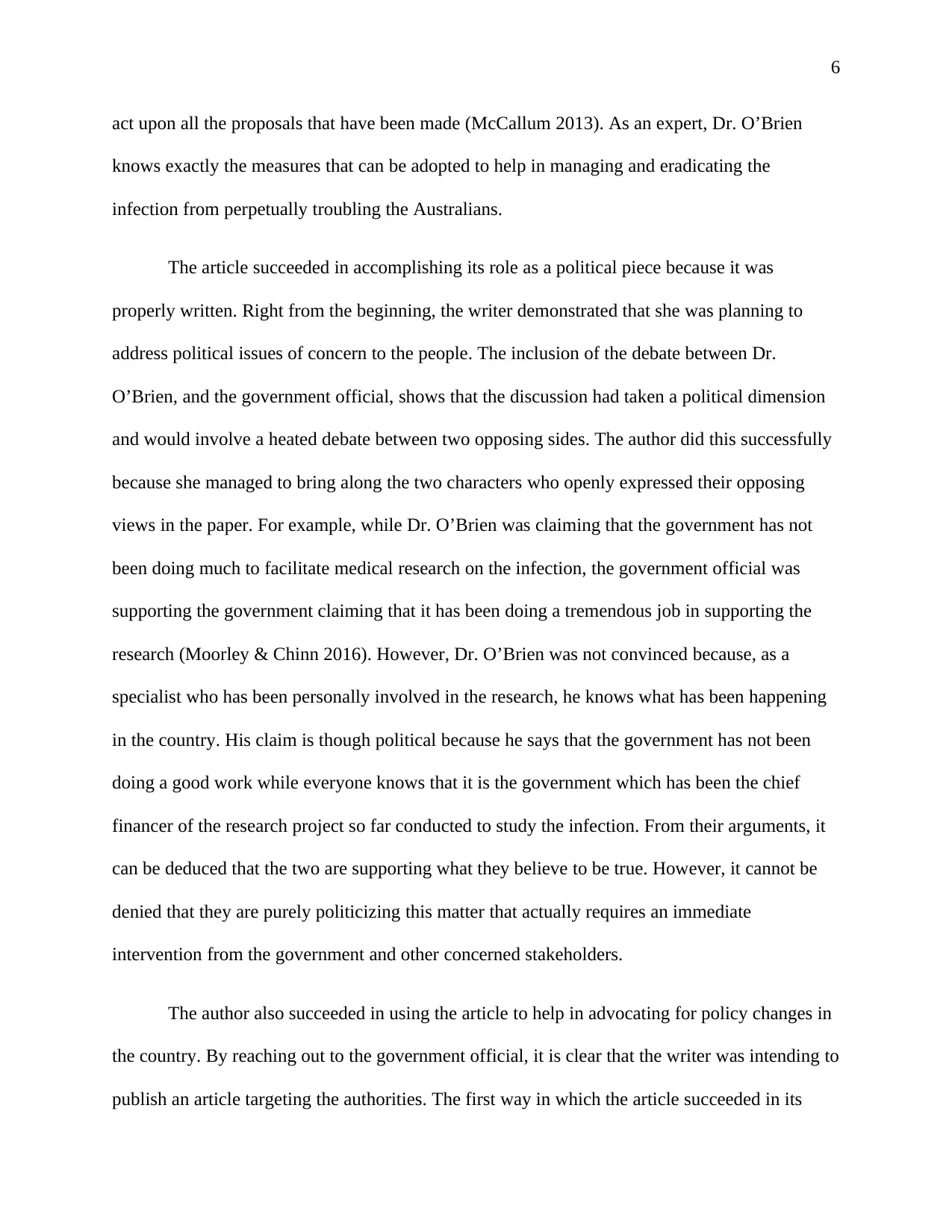
6
act upon all the proposals that have been made (McCallum 2013). As an expert, Dr. O’Brien
knows exactly the measures that can be adopted to help in managing and eradicating the
infection from perpetually troubling the Australians.
The article succeeded in accomplishing its role as a political piece because it was
properly written. Right from the beginning, the writer demonstrated that she was planning to
address political issues of concern to the people. The inclusion of the debate between Dr.
O’Brien, and the government official, shows that the discussion had taken a political dimension
and would involve a heated debate between two opposing sides. The author did this successfully
because she managed to bring along the two characters who openly expressed their opposing
views in the paper. For example, while Dr. O’Brien was claiming that the government has not
been doing much to facilitate medical research on the infection, the government official was
supporting the government claiming that it has been doing a tremendous job in supporting the
research (Moorley & Chinn 2016). However, Dr. O’Brien was not convinced because, as a
specialist who has been personally involved in the research, he knows what has been happening
in the country. His claim is though political because he says that the government has not been
doing a good work while everyone knows that it is the government which has been the chief
financer of the research project so far conducted to study the infection. From their arguments, it
can be deduced that the two are supporting what they believe to be true. However, it cannot be
denied that they are purely politicizing this matter that actually requires an immediate
intervention from the government and other concerned stakeholders.
The author also succeeded in using the article to help in advocating for policy changes in
the country. By reaching out to the government official, it is clear that the writer was intending to
publish an article targeting the authorities. The first way in which the article succeeded in its
act upon all the proposals that have been made (McCallum 2013). As an expert, Dr. O’Brien
knows exactly the measures that can be adopted to help in managing and eradicating the
infection from perpetually troubling the Australians.
The article succeeded in accomplishing its role as a political piece because it was
properly written. Right from the beginning, the writer demonstrated that she was planning to
address political issues of concern to the people. The inclusion of the debate between Dr.
O’Brien, and the government official, shows that the discussion had taken a political dimension
and would involve a heated debate between two opposing sides. The author did this successfully
because she managed to bring along the two characters who openly expressed their opposing
views in the paper. For example, while Dr. O’Brien was claiming that the government has not
been doing much to facilitate medical research on the infection, the government official was
supporting the government claiming that it has been doing a tremendous job in supporting the
research (Moorley & Chinn 2016). However, Dr. O’Brien was not convinced because, as a
specialist who has been personally involved in the research, he knows what has been happening
in the country. His claim is though political because he says that the government has not been
doing a good work while everyone knows that it is the government which has been the chief
financer of the research project so far conducted to study the infection. From their arguments, it
can be deduced that the two are supporting what they believe to be true. However, it cannot be
denied that they are purely politicizing this matter that actually requires an immediate
intervention from the government and other concerned stakeholders.
The author also succeeded in using the article to help in advocating for policy changes in
the country. By reaching out to the government official, it is clear that the writer was intending to
publish an article targeting the authorities. The first way in which the article succeeded in its
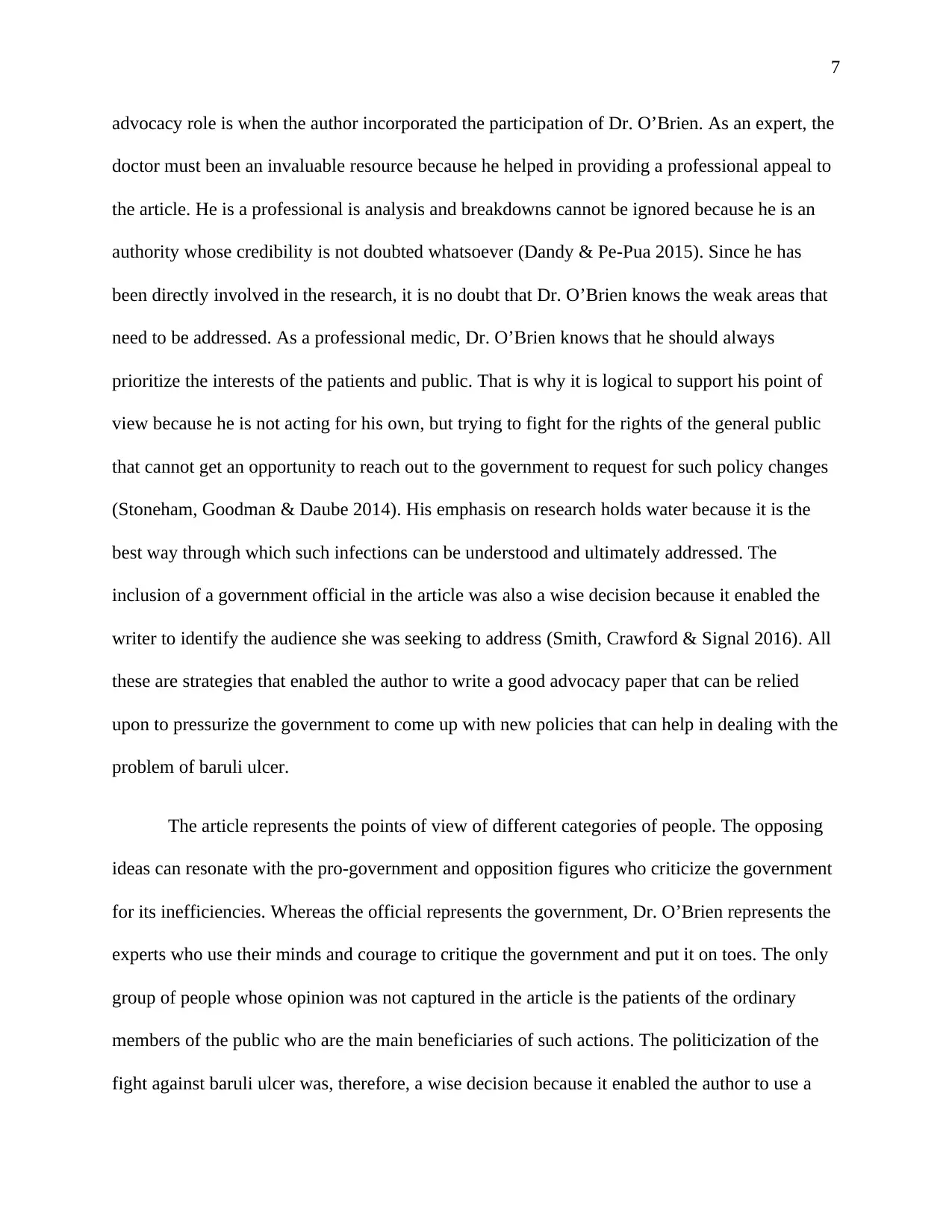
7
advocacy role is when the author incorporated the participation of Dr. O’Brien. As an expert, the
doctor must been an invaluable resource because he helped in providing a professional appeal to
the article. He is a professional is analysis and breakdowns cannot be ignored because he is an
authority whose credibility is not doubted whatsoever (Dandy & Pe-Pua 2015). Since he has
been directly involved in the research, it is no doubt that Dr. O’Brien knows the weak areas that
need to be addressed. As a professional medic, Dr. O’Brien knows that he should always
prioritize the interests of the patients and public. That is why it is logical to support his point of
view because he is not acting for his own, but trying to fight for the rights of the general public
that cannot get an opportunity to reach out to the government to request for such policy changes
(Stoneham, Goodman & Daube 2014). His emphasis on research holds water because it is the
best way through which such infections can be understood and ultimately addressed. The
inclusion of a government official in the article was also a wise decision because it enabled the
writer to identify the audience she was seeking to address (Smith, Crawford & Signal 2016). All
these are strategies that enabled the author to write a good advocacy paper that can be relied
upon to pressurize the government to come up with new policies that can help in dealing with the
problem of baruli ulcer.
The article represents the points of view of different categories of people. The opposing
ideas can resonate with the pro-government and opposition figures who criticize the government
for its inefficiencies. Whereas the official represents the government, Dr. O’Brien represents the
experts who use their minds and courage to critique the government and put it on toes. The only
group of people whose opinion was not captured in the article is the patients of the ordinary
members of the public who are the main beneficiaries of such actions. The politicization of the
fight against baruli ulcer was, therefore, a wise decision because it enabled the author to use a
advocacy role is when the author incorporated the participation of Dr. O’Brien. As an expert, the
doctor must been an invaluable resource because he helped in providing a professional appeal to
the article. He is a professional is analysis and breakdowns cannot be ignored because he is an
authority whose credibility is not doubted whatsoever (Dandy & Pe-Pua 2015). Since he has
been directly involved in the research, it is no doubt that Dr. O’Brien knows the weak areas that
need to be addressed. As a professional medic, Dr. O’Brien knows that he should always
prioritize the interests of the patients and public. That is why it is logical to support his point of
view because he is not acting for his own, but trying to fight for the rights of the general public
that cannot get an opportunity to reach out to the government to request for such policy changes
(Stoneham, Goodman & Daube 2014). His emphasis on research holds water because it is the
best way through which such infections can be understood and ultimately addressed. The
inclusion of a government official in the article was also a wise decision because it enabled the
writer to identify the audience she was seeking to address (Smith, Crawford & Signal 2016). All
these are strategies that enabled the author to write a good advocacy paper that can be relied
upon to pressurize the government to come up with new policies that can help in dealing with the
problem of baruli ulcer.
The article represents the points of view of different categories of people. The opposing
ideas can resonate with the pro-government and opposition figures who criticize the government
for its inefficiencies. Whereas the official represents the government, Dr. O’Brien represents the
experts who use their minds and courage to critique the government and put it on toes. The only
group of people whose opinion was not captured in the article is the patients of the ordinary
members of the public who are the main beneficiaries of such actions. The politicization of the
fight against baruli ulcer was, therefore, a wise decision because it enabled the author to use a
Paraphrase This Document
Need a fresh take? Get an instant paraphrase of this document with our AI Paraphraser
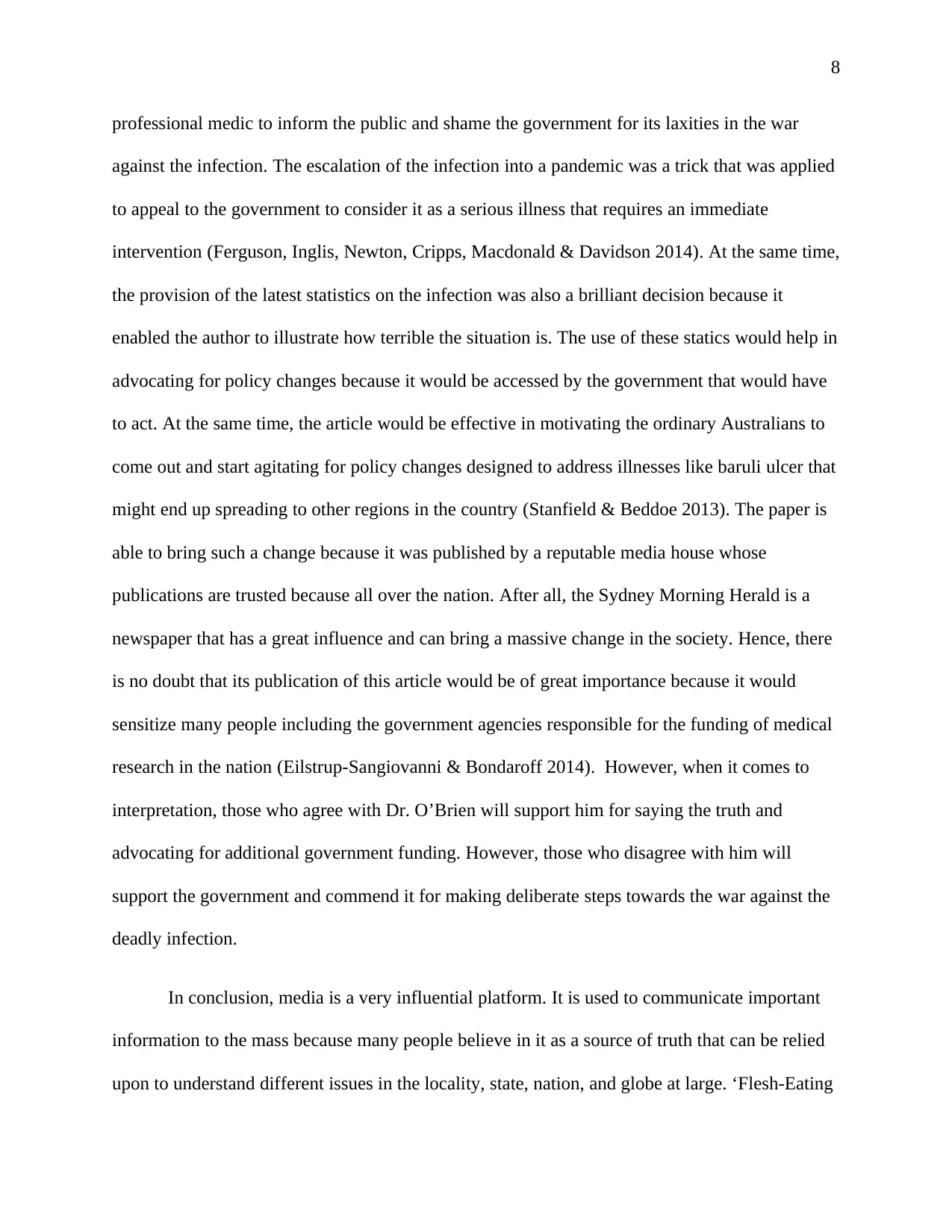
8
professional medic to inform the public and shame the government for its laxities in the war
against the infection. The escalation of the infection into a pandemic was a trick that was applied
to appeal to the government to consider it as a serious illness that requires an immediate
intervention (Ferguson, Inglis, Newton, Cripps, Macdonald & Davidson 2014). At the same time,
the provision of the latest statistics on the infection was also a brilliant decision because it
enabled the author to illustrate how terrible the situation is. The use of these statics would help in
advocating for policy changes because it would be accessed by the government that would have
to act. At the same time, the article would be effective in motivating the ordinary Australians to
come out and start agitating for policy changes designed to address illnesses like baruli ulcer that
might end up spreading to other regions in the country (Stanfield & Beddoe 2013). The paper is
able to bring such a change because it was published by a reputable media house whose
publications are trusted because all over the nation. After all, the Sydney Morning Herald is a
newspaper that has a great influence and can bring a massive change in the society. Hence, there
is no doubt that its publication of this article would be of great importance because it would
sensitize many people including the government agencies responsible for the funding of medical
research in the nation (Eilstrup-Sangiovanni & Bondaroff 2014). However, when it comes to
interpretation, those who agree with Dr. O’Brien will support him for saying the truth and
advocating for additional government funding. However, those who disagree with him will
support the government and commend it for making deliberate steps towards the war against the
deadly infection.
In conclusion, media is a very influential platform. It is used to communicate important
information to the mass because many people believe in it as a source of truth that can be relied
upon to understand different issues in the locality, state, nation, and globe at large. ‘Flesh-Eating
professional medic to inform the public and shame the government for its laxities in the war
against the infection. The escalation of the infection into a pandemic was a trick that was applied
to appeal to the government to consider it as a serious illness that requires an immediate
intervention (Ferguson, Inglis, Newton, Cripps, Macdonald & Davidson 2014). At the same time,
the provision of the latest statistics on the infection was also a brilliant decision because it
enabled the author to illustrate how terrible the situation is. The use of these statics would help in
advocating for policy changes because it would be accessed by the government that would have
to act. At the same time, the article would be effective in motivating the ordinary Australians to
come out and start agitating for policy changes designed to address illnesses like baruli ulcer that
might end up spreading to other regions in the country (Stanfield & Beddoe 2013). The paper is
able to bring such a change because it was published by a reputable media house whose
publications are trusted because all over the nation. After all, the Sydney Morning Herald is a
newspaper that has a great influence and can bring a massive change in the society. Hence, there
is no doubt that its publication of this article would be of great importance because it would
sensitize many people including the government agencies responsible for the funding of medical
research in the nation (Eilstrup-Sangiovanni & Bondaroff 2014). However, when it comes to
interpretation, those who agree with Dr. O’Brien will support him for saying the truth and
advocating for additional government funding. However, those who disagree with him will
support the government and commend it for making deliberate steps towards the war against the
deadly infection.
In conclusion, media is a very influential platform. It is used to communicate important
information to the mass because many people believe in it as a source of truth that can be relied
upon to understand different issues in the locality, state, nation, and globe at large. ‘Flesh-Eating
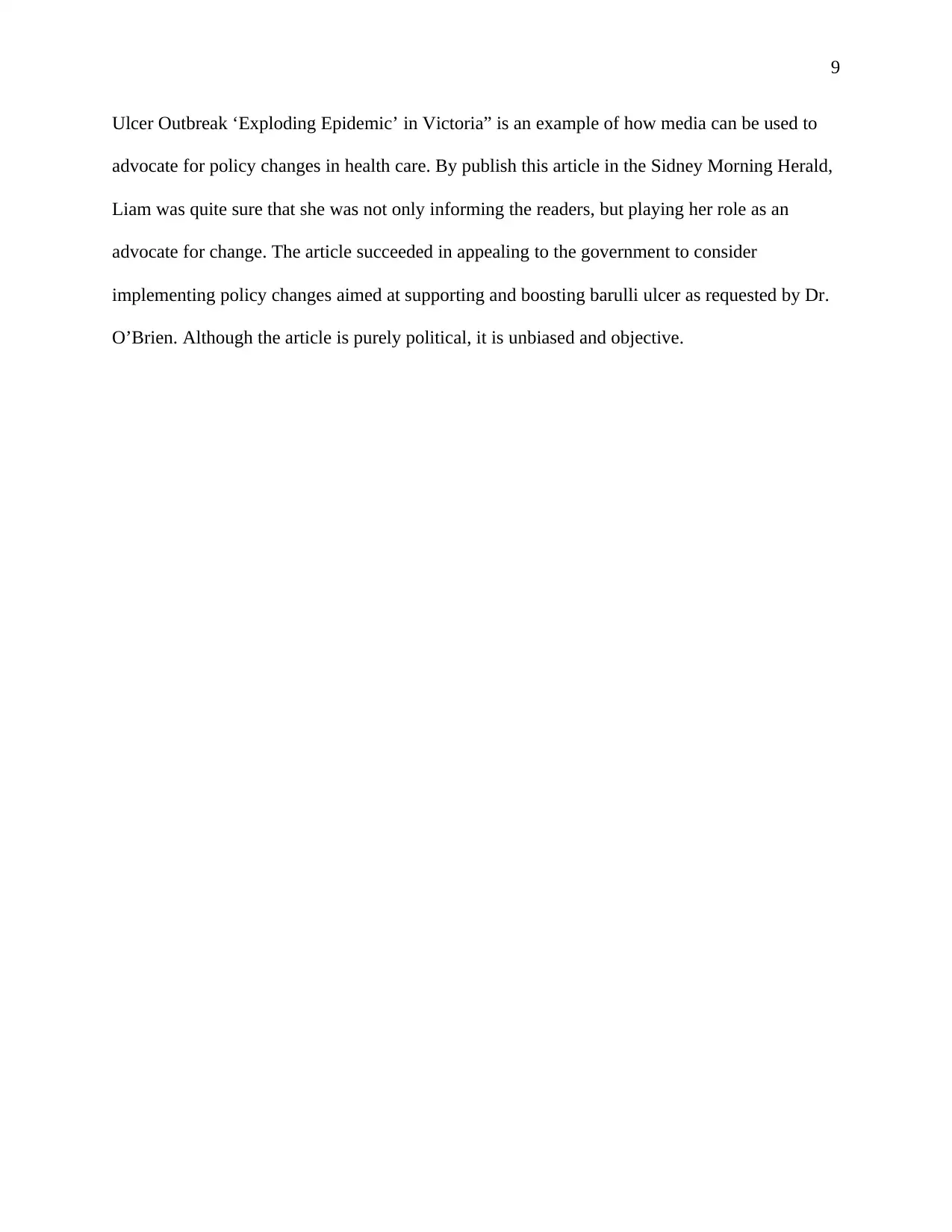
9
Ulcer Outbreak ‘Exploding Epidemic’ in Victoria” is an example of how media can be used to
advocate for policy changes in health care. By publish this article in the Sidney Morning Herald,
Liam was quite sure that she was not only informing the readers, but playing her role as an
advocate for change. The article succeeded in appealing to the government to consider
implementing policy changes aimed at supporting and boosting barulli ulcer as requested by Dr.
O’Brien. Although the article is purely political, it is unbiased and objective.
Ulcer Outbreak ‘Exploding Epidemic’ in Victoria” is an example of how media can be used to
advocate for policy changes in health care. By publish this article in the Sidney Morning Herald,
Liam was quite sure that she was not only informing the readers, but playing her role as an
advocate for change. The article succeeded in appealing to the government to consider
implementing policy changes aimed at supporting and boosting barulli ulcer as requested by Dr.
O’Brien. Although the article is purely political, it is unbiased and objective.
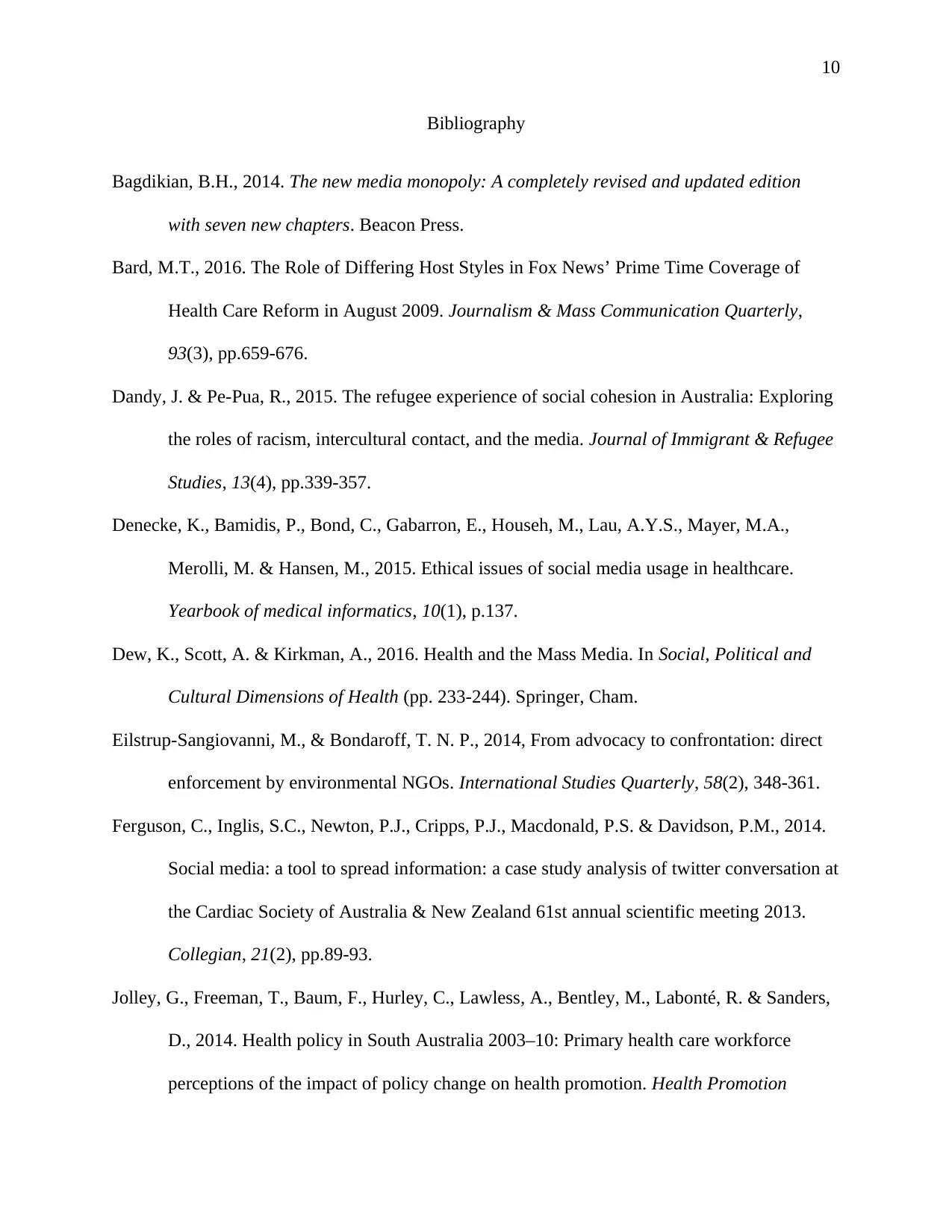
10
Bibliography
Bagdikian, B.H., 2014. The new media monopoly: A completely revised and updated edition
with seven new chapters. Beacon Press.
Bard, M.T., 2016. The Role of Differing Host Styles in Fox News’ Prime Time Coverage of
Health Care Reform in August 2009. Journalism & Mass Communication Quarterly,
93(3), pp.659-676.
Dandy, J. & Pe-Pua, R., 2015. The refugee experience of social cohesion in Australia: Exploring
the roles of racism, intercultural contact, and the media. Journal of Immigrant & Refugee
Studies, 13(4), pp.339-357.
Denecke, K., Bamidis, P., Bond, C., Gabarron, E., Househ, M., Lau, A.Y.S., Mayer, M.A.,
Merolli, M. & Hansen, M., 2015. Ethical issues of social media usage in healthcare.
Yearbook of medical informatics, 10(1), p.137.
Dew, K., Scott, A. & Kirkman, A., 2016. Health and the Mass Media. In Social, Political and
Cultural Dimensions of Health (pp. 233-244). Springer, Cham.
Eilstrup-Sangiovanni, M., & Bondaroff, T. N. P., 2014, From advocacy to confrontation: direct
enforcement by environmental NGOs. International Studies Quarterly, 58(2), 348-361.
Ferguson, C., Inglis, S.C., Newton, P.J., Cripps, P.J., Macdonald, P.S. & Davidson, P.M., 2014.
Social media: a tool to spread information: a case study analysis of twitter conversation at
the Cardiac Society of Australia & New Zealand 61st annual scientific meeting 2013.
Collegian, 21(2), pp.89-93.
Jolley, G., Freeman, T., Baum, F., Hurley, C., Lawless, A., Bentley, M., Labonté, R. & Sanders,
D., 2014. Health policy in South Australia 2003–10: Primary health care workforce
perceptions of the impact of policy change on health promotion. Health Promotion
Bibliography
Bagdikian, B.H., 2014. The new media monopoly: A completely revised and updated edition
with seven new chapters. Beacon Press.
Bard, M.T., 2016. The Role of Differing Host Styles in Fox News’ Prime Time Coverage of
Health Care Reform in August 2009. Journalism & Mass Communication Quarterly,
93(3), pp.659-676.
Dandy, J. & Pe-Pua, R., 2015. The refugee experience of social cohesion in Australia: Exploring
the roles of racism, intercultural contact, and the media. Journal of Immigrant & Refugee
Studies, 13(4), pp.339-357.
Denecke, K., Bamidis, P., Bond, C., Gabarron, E., Househ, M., Lau, A.Y.S., Mayer, M.A.,
Merolli, M. & Hansen, M., 2015. Ethical issues of social media usage in healthcare.
Yearbook of medical informatics, 10(1), p.137.
Dew, K., Scott, A. & Kirkman, A., 2016. Health and the Mass Media. In Social, Political and
Cultural Dimensions of Health (pp. 233-244). Springer, Cham.
Eilstrup-Sangiovanni, M., & Bondaroff, T. N. P., 2014, From advocacy to confrontation: direct
enforcement by environmental NGOs. International Studies Quarterly, 58(2), 348-361.
Ferguson, C., Inglis, S.C., Newton, P.J., Cripps, P.J., Macdonald, P.S. & Davidson, P.M., 2014.
Social media: a tool to spread information: a case study analysis of twitter conversation at
the Cardiac Society of Australia & New Zealand 61st annual scientific meeting 2013.
Collegian, 21(2), pp.89-93.
Jolley, G., Freeman, T., Baum, F., Hurley, C., Lawless, A., Bentley, M., Labonté, R. & Sanders,
D., 2014. Health policy in South Australia 2003–10: Primary health care workforce
perceptions of the impact of policy change on health promotion. Health Promotion
Secure Best Marks with AI Grader
Need help grading? Try our AI Grader for instant feedback on your assignments.
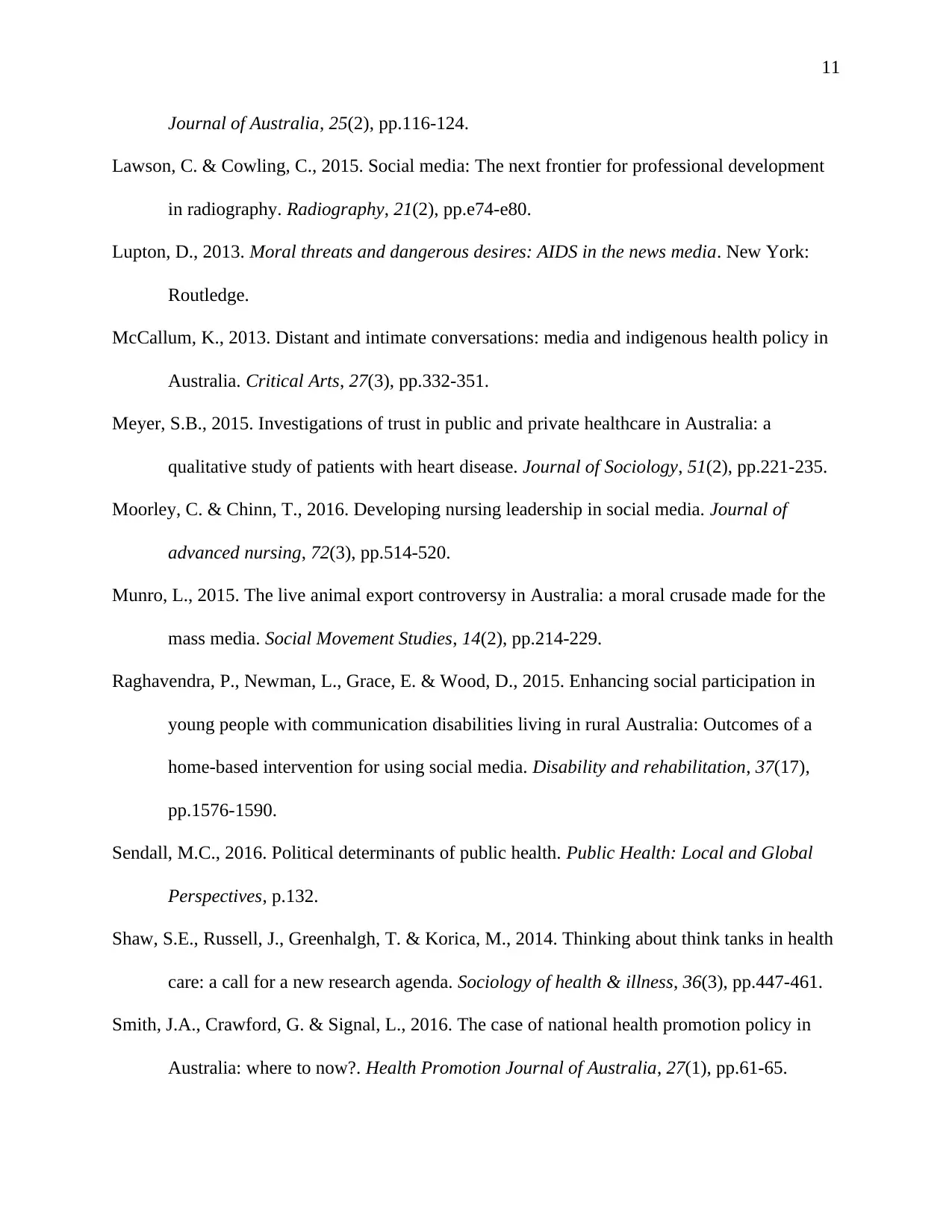
11
Journal of Australia, 25(2), pp.116-124.
Lawson, C. & Cowling, C., 2015. Social media: The next frontier for professional development
in radiography. Radiography, 21(2), pp.e74-e80.
Lupton, D., 2013. Moral threats and dangerous desires: AIDS in the news media. New York:
Routledge.
McCallum, K., 2013. Distant and intimate conversations: media and indigenous health policy in
Australia. Critical Arts, 27(3), pp.332-351.
Meyer, S.B., 2015. Investigations of trust in public and private healthcare in Australia: a
qualitative study of patients with heart disease. Journal of Sociology, 51(2), pp.221-235.
Moorley, C. & Chinn, T., 2016. Developing nursing leadership in social media. Journal of
advanced nursing, 72(3), pp.514-520.
Munro, L., 2015. The live animal export controversy in Australia: a moral crusade made for the
mass media. Social Movement Studies, 14(2), pp.214-229.
Raghavendra, P., Newman, L., Grace, E. & Wood, D., 2015. Enhancing social participation in
young people with communication disabilities living in rural Australia: Outcomes of a
home-based intervention for using social media. Disability and rehabilitation, 37(17),
pp.1576-1590.
Sendall, M.C., 2016. Political determinants of public health. Public Health: Local and Global
Perspectives, p.132.
Shaw, S.E., Russell, J., Greenhalgh, T. & Korica, M., 2014. Thinking about think tanks in health
care: a call for a new research agenda. Sociology of health & illness, 36(3), pp.447-461.
Smith, J.A., Crawford, G. & Signal, L., 2016. The case of national health promotion policy in
Australia: where to now?. Health Promotion Journal of Australia, 27(1), pp.61-65.
Journal of Australia, 25(2), pp.116-124.
Lawson, C. & Cowling, C., 2015. Social media: The next frontier for professional development
in radiography. Radiography, 21(2), pp.e74-e80.
Lupton, D., 2013. Moral threats and dangerous desires: AIDS in the news media. New York:
Routledge.
McCallum, K., 2013. Distant and intimate conversations: media and indigenous health policy in
Australia. Critical Arts, 27(3), pp.332-351.
Meyer, S.B., 2015. Investigations of trust in public and private healthcare in Australia: a
qualitative study of patients with heart disease. Journal of Sociology, 51(2), pp.221-235.
Moorley, C. & Chinn, T., 2016. Developing nursing leadership in social media. Journal of
advanced nursing, 72(3), pp.514-520.
Munro, L., 2015. The live animal export controversy in Australia: a moral crusade made for the
mass media. Social Movement Studies, 14(2), pp.214-229.
Raghavendra, P., Newman, L., Grace, E. & Wood, D., 2015. Enhancing social participation in
young people with communication disabilities living in rural Australia: Outcomes of a
home-based intervention for using social media. Disability and rehabilitation, 37(17),
pp.1576-1590.
Sendall, M.C., 2016. Political determinants of public health. Public Health: Local and Global
Perspectives, p.132.
Shaw, S.E., Russell, J., Greenhalgh, T. & Korica, M., 2014. Thinking about think tanks in health
care: a call for a new research agenda. Sociology of health & illness, 36(3), pp.447-461.
Smith, J.A., Crawford, G. & Signal, L., 2016. The case of national health promotion policy in
Australia: where to now?. Health Promotion Journal of Australia, 27(1), pp.61-65.
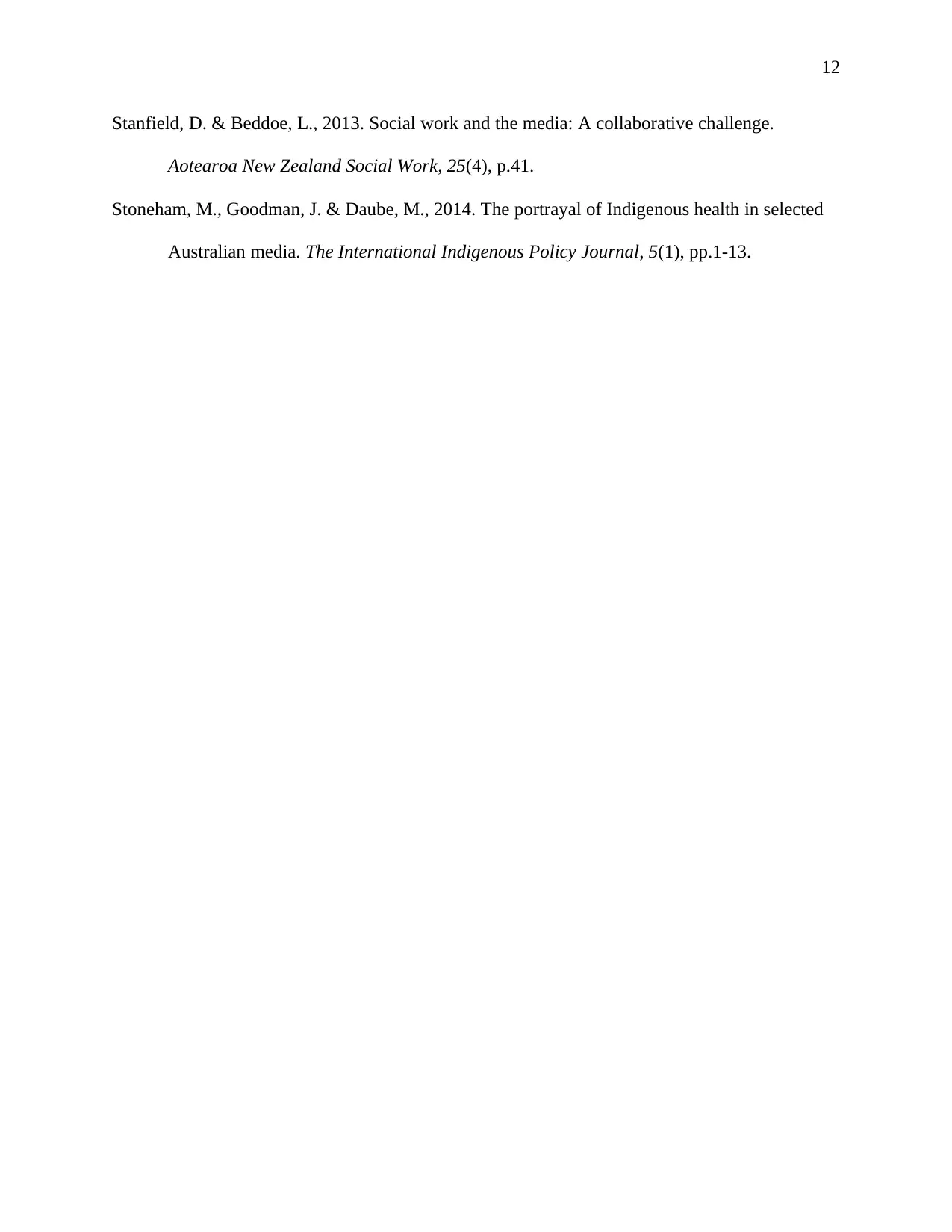
12
Stanfield, D. & Beddoe, L., 2013. Social work and the media: A collaborative challenge.
Aotearoa New Zealand Social Work, 25(4), p.41.
Stoneham, M., Goodman, J. & Daube, M., 2014. The portrayal of Indigenous health in selected
Australian media. The International Indigenous Policy Journal, 5(1), pp.1-13.
Stanfield, D. & Beddoe, L., 2013. Social work and the media: A collaborative challenge.
Aotearoa New Zealand Social Work, 25(4), p.41.
Stoneham, M., Goodman, J. & Daube, M., 2014. The portrayal of Indigenous health in selected
Australian media. The International Indigenous Policy Journal, 5(1), pp.1-13.
1 out of 12
Your All-in-One AI-Powered Toolkit for Academic Success.
+13062052269
info@desklib.com
Available 24*7 on WhatsApp / Email
![[object Object]](/_next/static/media/star-bottom.7253800d.svg)
Unlock your academic potential
© 2024 | Zucol Services PVT LTD | All rights reserved.

